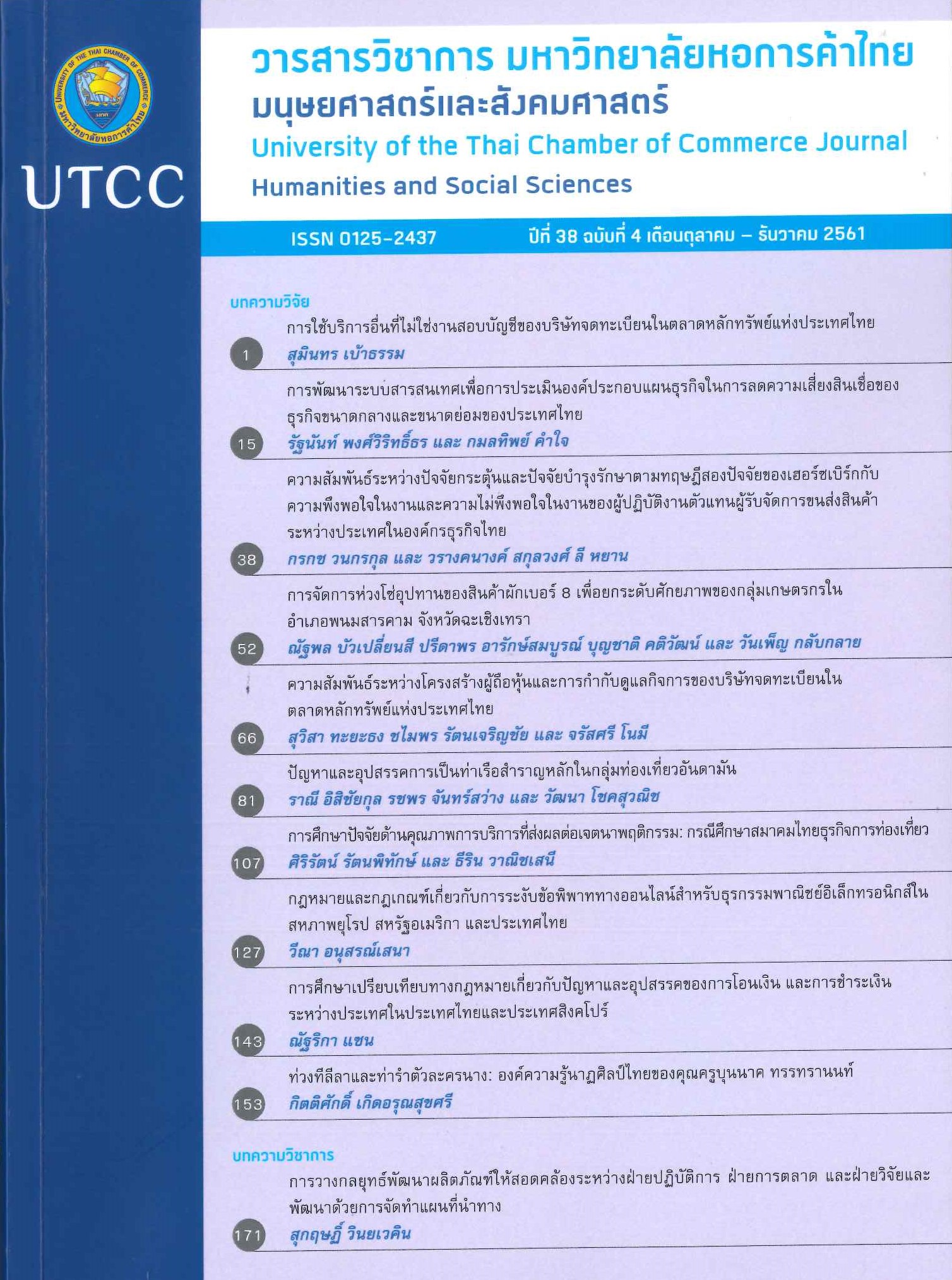The Relationship between Ownership Structure and Corporate Governance of Listed Companies in the Stock Exchange of Thailand
Main Article Content
Abstract
The purpose of this paper is to investigate the effect of ownership structure on corporate governance in Thailand. Structure of the ownership is measured by the ratio of individual shareholders ownership and other institutions’ ownership such as director ownership, financial institute ownership, foreign ownership and government ownership which took a role in the management and policy for the listed companies. We used data from the year 2016 annual reports of 527 listed companies. Multiple regression analysis was performed to examine factors influencing corporate governance. The results indicate that the dispersed shareholding which was
measured by the percentage of Free Float which reflects the individual shareholders ownership has positively and significantly affected corporate governance scoring. This empirical research, nonetheless, confirm that diversified shareholders and institutional investors are the main drive for better corporate governance.
Article Details
ลิขสิทธิ์ของบทความ
ผลงานที่ได้รับการตีพิมพ์ถือเป็นลิขสิทธิ์ของมหาวิทยาลัยหอการค้าไทย ห้ามมิให้นำเนื้อหา ทัศนะ หรือข้อคิดเห็นใด ๆ ของผลงานไปทำซ้ำ ดัดแปลง หรือเผยแพร่ ไม่ว่าทั้งหมดหรือบางส่วนโดยไม่ได้รับอนุญาตเป็นลายลักษณ์อักษรจากมหาวิทยาลัยหอการค้าไทยก่อน
References
ตลาดหลักทรัพย์แห่งประเทศไทย. (2560). หลักการกำกับดูแลกิจการที่ดี สำหรับบริษัทจดทะเบียนปี 2560. สืบค้นเมื่อ8 มีนาคม 2560, จากhttps://www.cgthailand.org/microsite/documents/CGCode.pdf
ภัทรพงศ์ เจริญกิจจารุกร. (2557). Sarbanes-Oxley Act และการกำกับดูแลกิจการในต่างประเทศ สู่ธรรมาภิบาลในประเทศไทย. จุฬาลงกรณ์ธุรกิจปริทัศน์, 35(4), 92-119.
ภัทรพงศ์ เจริญกิจจารุกร. (2559). ผลคะแนนการประเมินการกำกับดูแลกิจการกับมูลค่าธุรกิจของบริษัทจดทะเบียนกลุ่มดัชนี SET 50: บทบาทและความสัมพันธ์ของผู้ถือหุ้นรายใหญ่. วารสารวิทยาการจัดการสมัยใหม่ คณะวิทยาการจัดการ มหาวิทยาลัยราชภัฏลําปาง, 9(1). 31-45.ฅ
ภาณุพงษ์ โมกไธสง, สุพรรณี บัวสุข, เกตุจันทร์ จำปาไชยศรี, และรวี ลงกาปี. (2557). ความสัมพันธ์ระหว่างกลไกการกำกับดูแลกิจการ โครงสร้างของผู้ถือหุ้น ต้นทุน ตัวแทน กับ คุณภาพกำไรของกิจการจดทะเบียนในตลาดหลักทรัพย์ของประเทศไทย. วารสารวิทยาการจัดการสมัยใหม่คณะวิทยาการจัดการ มหาวิทยาลัยราชภัฏลําปาง, 7(1), 1-10.
วรกมล เกษมทรัพย์. (2553). ความสัมพันธ์ระหว่างการกำกับดูแลกิจการและผลการดำเนินงานของกิจการที่จดทะเบียนในตลาดหลักทรัพย์แห่งประเทศไทย (การศึกษาอิสระ ไม่ได้ตีพิมพ์). มหาวิทยาลัยธรรมศาสตร์, กรุงเทพฯ.
สถาบันกรรมการบริษัทไทย. (2560). Corporate governance report of Thai listed companies: 2016. สืบคืนเมื่อ 1 กันยายน 2560, จาก https://www.thai-iod.com/imgUpload
/CGR%202016%20Report(1).pdf
สุรางค์ เห็นสว่าง. (2561). ผลกระทบจากระดับคะแนนการประเมินการกำกับดูแลกิจการและโครงสร้างผู้ถือหุ้นต่อผลตอบแทนส่วนเกินและผลประกอบการเชิงการเงิน : การศึกษาเชิงประจักษ์ในตลาดหลักทรัพย์ แห่งประเทศไทย. วารสารสถาบันเทคโนโลยีแห่งสุวรรณภูมิ, 3(2), 35-51.
Ang, J. S., & Ding, D. K. (2006). Government ownership and the performance of government-linked companies: The case of Singapore. Journal of Multinational Financial Management, 16(1), 64-88.
Anum Mohd Ghazali, N. (2010). Ownership structure, corporate governance and corporate performance in Malaysia. International Journal of Commerce and Management, 20(2), 109-119.
Claessens, S., Djankov, S., & Lang, L. H. (2000). The separation of ownership and control in East Asian corporations. Journal of Financial Economics, 58(1-2), 81-112.
Darmadi, S. (2016). Ownership concentration, family control, and auditor choice: Evidence from an emerging market. Asian Review of Accounting, 24(1), 19-42.
Davis, J. H., Schoorman, F. D., & Donaldson, L. (1997). Toward a stewardship theory of management. Academy of Management Review, 22(1), 20-47.
Fama, E. F., & Jensen, M. C. (1983). Separation of ownership and control. The Journal of Law and Economics, 26(2), 301-325.
Graves, S. B., & Waddock, S. A. (1994). Institutional owners and corporate social performance. Academy of Management Journal, 37(4), 1034-1046.
Haniffa, R. M., & Cooke, T. E. (2002). Culture, corporate governance and disclosure in Malaysian corporations. Abacus, 38(3), 317-349.
La Porta, R., Lopez-de-Silanes, F., & Shleifer, A. (1999). Corporate ownership around the world. The Journal of Finance, 54(2), 471-517.
Shleifer, A., & Vishny, R. W. (1997). A survey of corporate governance. The Journal of Finance, 52(2), 737-783.


